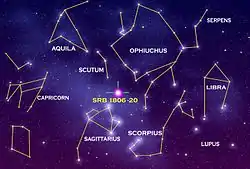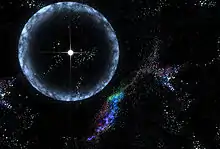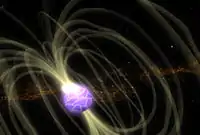SGR 1806−20
SGR 1806−20 is a magnetar, a type of neutron star with a very powerful magnetic field, that was discovered in 1979 and identified as a soft gamma repeater. SGR 1806−20 is located about 14.5 kiloparsecs (50,000 light-years) from Earth on the far side of the Milky Way in the constellation of Sagittarius. It has a diameter of no more than 20 kilometres (12 mi) and rotates on its axis every 7.5 seconds (30,000 km/h rotation speed at the surface). As of 2016, SGR 1806-20 is the most highly magnetized object ever observed, with a magnetic field over 1015 gauss (G) (1011 tesla) in intensity[1] (compared to the Sun's 1–5 G and Earth's 0.25–0.65 G).
 This is where SGR 1806-20 would appear in the sky if it were visible to human eyes. | |
| Observation data Epoch J2000 Equinox J2000 | |
|---|---|
| Constellation | Sagittarius |
| Right ascension | 18h 08m 39.32s |
| Declination | −20° 24' 39.5"' |
| Apparent magnitude (V) | totally obscured |
| Astrometry | |
| Distance | 50,000 ly (14,500 pc) |
| Other designations | |
| Database references | |
| SIMBAD | data |
Explosion


Fifty thousand years after a starquake occurred on the surface of SGR 1806-20, the radiation from the resultant explosion reached Earth on December 27, 2004 (GRB 041227).[2] In terms of gamma rays, the burst had an absolute magnitude around −29.[lower-alpha 1] It was the brightest event known to have been sighted on this planet from an origin outside the Solar System, until the GRB 080319B. The magnetar released more energy in one-tenth of a second (1.0×1040 J) than the Sun releases in 150,000 years (4×1026 W × 4.8×1012 s = 1.85×1039 J).[3] Such a burst is thought to be the largest explosion observed in this galaxy by humans since the SN 1604 supernova observed by Johannes Kepler in 1604. The gamma rays struck Earth's ionosphere and created more ionization, which briefly expanded the ionosphere.
A similar blast within 3 parsecs (10 light years) of Earth would severely affect the atmosphere,[4] by destroying the ozone layer and causing mass extinction,[5][6] and be similar in effect to a 12-kiloton nuclear blast at 7.5 kilometers. The nearest known magnetar to Earth is 1E 1048.1-5937, located 9,000 light-years away in the constellation Carina.
Location
SGR 1806−20 lies at the core of radio nebula G10.0-0.3 and is a member of an open cluster named after it, itself a component of W31, one of the largest H II regions in the Milky Way. Cluster 1806-20 is made up of some highly unusual stars, including at least two carbon-rich Wolf–Rayet stars (WC9d and WCL), two blue hypergiants, and LBV 1806-20, one of the brightest/most massive stars in the galaxy.
See also
Notes
- As measured by various space-based and land-based astronomical observatories, including the Swift spacecraft.
References
- "Top story – Scientists measure the most powerful magnet known". NASA, Goddard Space Flight Center. 2002-11-04. Archived from the original on 2010-04-28. Retrieved 2011-12-29.
- "Cosmic Explosion Among the Brightest in Recorded History". NASA, Goddard Space Flight Center. 2005-02-18. Retrieved 2011-12-29.
- https://www.nasa.gov/vision/universe/watchtheskies/swift_nsu_0205.html NASA - Cosmic Explosion Among the Brightest in Recorded History
- "NASA - Cosmic Explosion Among the Brightest in Recorded History". www.nasa.gov. 18 February 2005. Retrieved 29 December 2020.
- Bob Berman (4 September 2015). "Weird Object: Magnetar SGR 1806-20". Astronomy.com. Retrieved 30 December 2020.
- "Harvard-Smithsonian Center For Astrophysics: Blast Affected Earth From Halfway Across The Milky Way". ScienceDaily. 23 February 2005. Retrieved 30 December 2020.
External links
| Wikimedia Commons has media related to SGR 1806-20. |
- Anniversary of a Cosmic Blast (Phil Plait Dec. 27, 2012)
- An exceptionally bright flare from SGR 1806-20 and the origins of short-duration big gamma-ray bursts, 2005-04-28 (Nature)
- Huge 'star-quake' rocks Milky Way, 2005-02-18, (BBC News Online)
- Brightest galactic flash ever detected hits Earth 2005-02-18 (space.com)
- 2005-02-20 (The Age) Registration required.
- Huge quake cracks star 2005-09-27 (space.com)
- NASA Sees Hidden Structure Of Neutron Star In Starquake (SpaceDaily) April 26, 2006